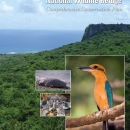What We Do
The National Wildlife Refuge System is a series of lands and waters owned and managed by the U.S. Fish and Wildlife Service. Wildlife conservation is at the heart of the refuge system. It drives everything we do from the purpose a refuge is established, to the recreational activities offered there, to the resource management tools we use. Selecting the right tools helps us ensure the survival of local plants and animals and helps fulfill the purpose of the refuge.
Management and Conservation
Refuges use a wide range of land management tools based on the best science available. Some refuges use prescribed fires to mimic natural fires that would have cleared old vegetation from the land helping native plants regenerate and local wildlife to thrive. Other refuges contain Wilderness areas where land is largely managed in passively. The management tools used are aimed at ensuring a balanced conservation approach where both wildlife and people will benefit.
One of the most important management functions of all refuges is protecting wildlife. Our management goals highlight this pivotal objective and include the following:
- Protect and manage endangered and threatened species and their habitats to promote recovery of the species that are or can be supported on the refuge
- Protect and enhance refuge habitat, both marine and terrestrial, to ensure suitable roosting, foraging, and nesting habitat is available for the suite of species that historically occurred on the refuge
- Relocate and protect swiftlets or rails and their habitat
- Protect and enhance endangered Serianthes and other rare plants
- Control the brown tree snake on the refuge
- Protect the coral reef and associated marine species
- Manage feral ungulates and other invasive species invasive species
An invasive species is any plant or animal that has spread or been introduced into a new area where they are, or could, cause harm to the environment, economy, or human, animal, or plant health. Their unwelcome presence can destroy ecosystems and cost millions of dollars.
Learn more about invasive species on the refuge to achieve refuge purposes - Monitor management results to make informed adaptive management decisions
- Expand partnerships with the Guam Department of Agriculture, University of Guam, DoD, and other conservation partners to increase benefits to natural resources
Our Services
Special Use Permit Guidelines
The Guam National Wildlife Refuge is supportive of all activities held at the Refuge as long as the activity is appropriate and compatible with the mission of the Refuge. We recommend viewing the linked information concerning Special Use Permits on the National Wildlife Refuges below. Visit the About Us page and the What We Do page to learn more about the Refuge.
To apply for a Special Use Permit at the Guam National Wildlife Refuge, find the correct permit application (the applications are on the bottom of the page) and send a completed application to ritidian@fws.gov.
- For activities with groups of 25 people or less, permit applications must be received at least 30 days before the start of the activity.
- For activities with groups exceeding 25 people, permit applications must be received at least 90 days before the start of the activity.
- For all commercial activities, permit applications must be received at least 90 days before the start of the activity.
- If the permit application is received outside of those timeframes, they will be denied.
If you have any questions, please contact the Refuge at ritidian@fws.gov or 671-355-5096.
Our Projects and Research
The Guam National Wildlife Refuge is implementing several exciting projects. Our major projects include the Cycad Health Assessment Project and a forest restoration project.
Law Enforcement
U.S. Fish and Wildlife Service law enforcement officers have a wide variety of duties and responsibilities. Officers help visitors understand and obey wildlife protection laws. They work closely with state and local government offices to enforce federal, state and refuge hunting regulations that protect migratory birds and other game species from illegal take and preserve legitimate hunting opportunities.
Laws and Regulations
Protecting resources and people on our refuges is the fundamental responsibility of refuge officers. The mission of the Refuge Law Enforcement Program is to support the administration of the National Wildlife Refuge System through the management and protection of natural, historic and cultural resources, property, and people on lands and waters of our national wildlife refuges. Law enforcement is an integral part of managing the National Wildlife Refuge System. Refuge law enforcement officers are responsible for upholding federal laws and regulations that protect natural resources, the public, and employees.




